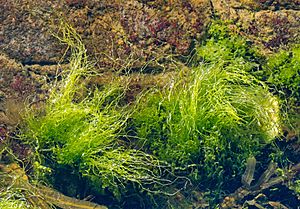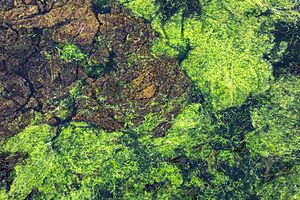Ulva intestinalis facts for kids
Quick facts for kids Ulva intestinalis |
|
|---|---|
 |
|
| Scientific classification | |
| Genus: |
Ulva
|
| Species: |
intestinalis
|
| Synonyms | |
|
|
Ulva intestinalis is a type of green alga. It belongs to the family Ulvaceae. People know it by several common names. These include sea lettuce, green bait weed, gutweed, and grass kelp. Before the early 2000s, this alga was in a different group called Enteromorpha. Scientists used genetic studies to reclassify it into the Ulva genus.
Contents
Where Ulva intestinalis Lives
This green alga can be found all over the world. It lives in many different places.
For example, you can find it in the Bering Sea near Alaska. It also grows around the Aleutian Islands and in Puget Sound.
In Asia, it is found in Japan, Korea, and the Philippines. You can also see it in Mexico and Russia.
In the Middle East, it lives in Israel. In Europe, it grows in the Azores, Belgium, Denmark, Ireland, Norway, and Poland. It is also common in the Baltic Sea and the Mediterranean Sea.
You can also find Ulva intestinalis along the shores of the Pacific Ocean, including in New Zealand.
What Ulva intestinalis Looks Like and How It Grows
The parts of this alga, called fronds, are like hollow tubes. They can grow up to 15 centimeters (about 6 inches) long or even more. The tubes get wider in the middle.
Inside the cells, the green parts (chloroplasts) are shaped like a hood. They are usually on one side of the cell. Each cell typically has one pyrenoid, which helps store food.
This alga can be anywhere from 10 to 30 centimeters (4 to 12 inches) long. It can also be 6 to 18 millimeters (about 0.2 to 0.7 inches) wide. The tips of the fronds are usually rounded.
Life Cycle of Ulva intestinalis
Ulva intestinalis can reproduce all year long. It has a special life cycle called "alternation of generations." This means it has two main stages that look exactly alike.
One stage is called the gametophyte. This stage produces reproductive cells. The other stage is called the sporophyte. This stage produces spores. Both stages look the same, even though they do different jobs in reproduction.
Sometimes, scientists divide Ulva intestinalis into two types. These are ssp. intestinalis and ssp. compressa.
See also
 In Spanish: Ulva intestinalis para niños
In Spanish: Ulva intestinalis para niños


